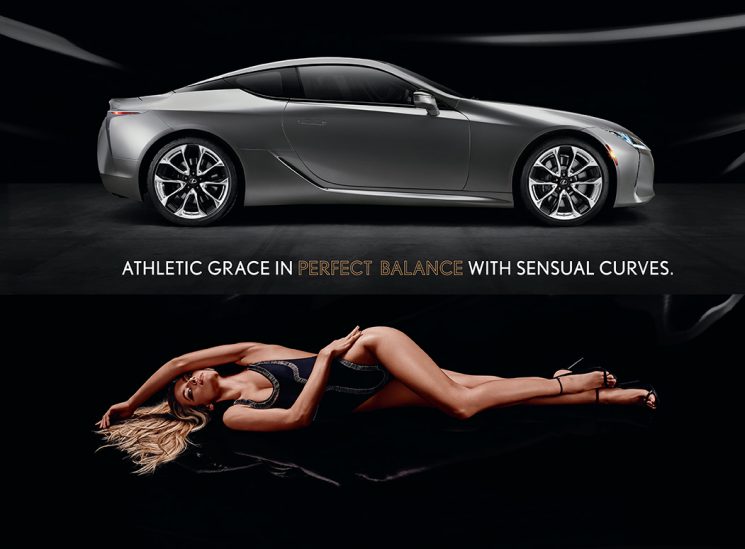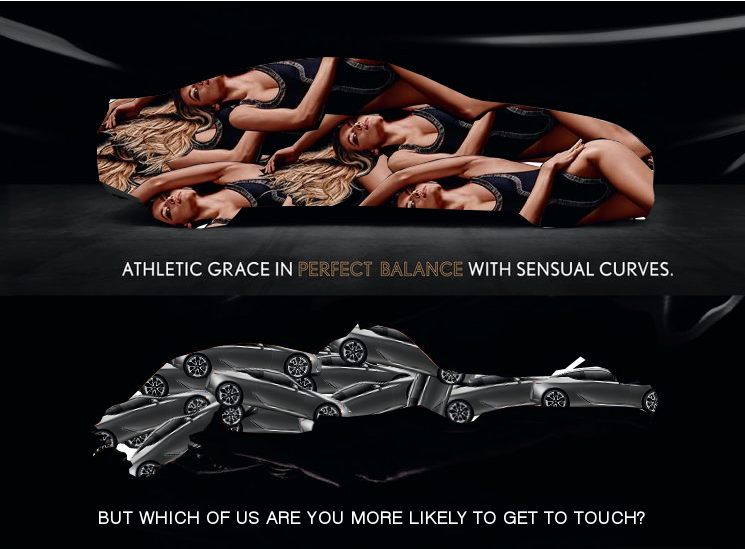
This campaign for the Lexus LC-500 published in March this year utilized Sports Illustrated Swimsuit model Hannah Ferguson to aid in the sales of their cars. While the campaign has a series of shots that compare features of Hannah to those of the LC-500, this one is specifically interesting for a variety of reasons.
The ad shows an image of the car above a photo of Hannah lying in a sensual way beneath it. The text running between the two pictures states: ‘Athletic grace in perfect balance with sensual curves,’ creating an obvious double entendre between Hannah and the car. These words intend to equate women and the car, which not only attempts to sexualize and personify an inanimate object, but also seeks to objectify women in an obvious way.
The objectification of women in media is an ongoing problem and one this ad chose to participate in. In our society, there is a tendency to gender objects, and this is the case with vehicles, which oftentimes are referred to as a ‘her.’ This blatant comparison in this ad instills an idea that, like vehicles, women can be bought as well as controlled. This is further emphasized in the positioning of Hannah in the ad. She is placed on her back, twisted in an awkward and weak position, with her hands above her head. This position indicates that she is submissive and vulnerable. Thus, the advertisement is a sufficient example of the Male Gaze—positioning the viewer of the advertisement as male, powerful and in control, while the woman is to be looked at and consumed as the car is.
This ad perpetuates the idea of women as the weaker sex, while attempting to promote a vehicle, which they label as powerful. This demonstrates how little thought into how women is used in their ads, and instead focuses on the long-standing belief that sex sells.
_______________

My Lexus ad focuses on highlighting the ridiculousness in the comparison of women and cars. To do this, I left the outlines for the LC-500 and Hannah and switched what was inside their outlines. The sizes and shapes of these images were clearly completely different; therefore, the outlines have numerous copies of the internal images. This created an image that clearly demonstrates why, despite the words scrawling across the middle of the ad, that women and cars are actually not the same at all. This was a key point in Lexus’s ad campaign not only in this image, but the rest of the photographs as well.
By switching the images in the outlines, it also highlights the awkwardness of the position in which the model was posed. The position of Hannah in the original ad is one seen so often with women in the media. Due to this, it is easy to overlook how she has been posed in a position in order to convey vulnerability and submissiveness. In switching the images, the outline of the car still looks like a car; however, the outline of Hannah is almost completely unrecognizable.
I also chose to add the text along the bottom that says, ‘But which of us are you more likely to touch?’ The purpose of the text is to further emphasize the problems with objectification of women by pointing out the absurdity that women and cars are interchangeable. The ad suggests that, while a Sports Illustrated Swimsuit model may be out of reach, a car is a suitable and equal replacement for her. By placing the words along the bottom and keeping the current text, it brings to light the intentions of the advertisers to the viewer. While the objectification was always the focus of these ads, adding the text makes this suggestion undeniable.
Overall, by editing the Lexus LC-500 ad to highlight the problematic nature of this ad, I was able to demonstrate why the comparison of women and inanimate object is an issue, and why advertisers should be more conscientious about the use of women in their ads.